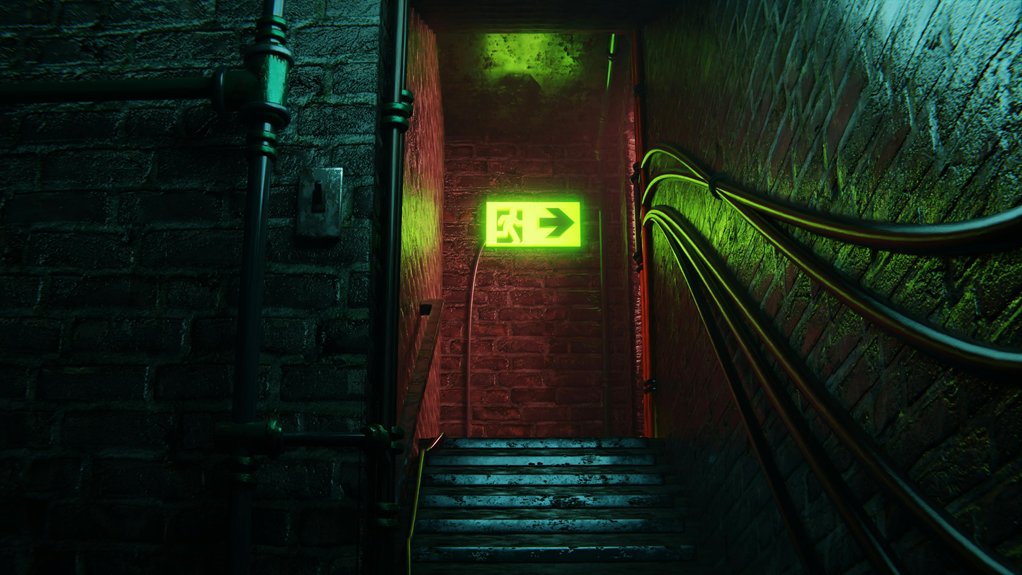If you’re a homeowner in Ann Arbor, it’s essential to keep an eye out for signs that your basement might need waterproofing. You might notice musty odors or damp walls, which are clear indicators of moisture issues. Water stains and visible mold can also pose health risks. Ignoring these signs could lead to bigger problems down the line. Let’s explore the key indicators that could save you from extensive damage.
Key Takeaways
- Musty odors in the basement indicate trapped dampness and potential mold growth, requiring immediate ventilation and moisture management.
- Damp or discolored walls often signal mold presence, risking health and structural integrity if not addressed promptly.
- Water stains on floors or walls suggest underlying moisture issues that can compromise both health and the basement’s structure.
- Visible mold growth is a serious health risk and indicates poor ventilation or leaks that must be resolved immediately.
- Cracks in the foundation, particularly widening or horizontal ones, reveal moisture intrusion and require prompt attention to prevent costly repairs.
Musty Odors in the Basement
When you step into your basement and notice a musty odor, it’s often a sign that moisture is lurking where it shouldn’t be.
Musty smells indicate that dampness might be trapped in the air, creating an environment ripe for mold growth.
Musty odors signal trapped dampness, fostering conditions perfect for mold growth.
To combat this, make certain your basement ventilation is adequate. Open windows when possible, use fans, or invest in a dehumidifier to keep humidity levels in check.
Regularly check for leaks or condensation, as these can contribute to the unpleasant odors.
Addressing the issue promptly not only improves air quality but also protects your home from further damage.
Damp or Discolored Walls
If you notice damp or discolored walls in your basement, it’s vital to act quickly.
These signs often indicate mold growth, which can pose health risks, and they may also threaten your home’s structural integrity.
Ignoring these issues can lead to more extensive damage and costly repairs down the line.
Mold Growth Concerns
As you inspect your basement, noticing damp or discolored walls can be alarming, especially since these signs often indicate potential mold growth. Mold can greatly impact your indoor air quality, leading to health issues. If you see these indicators, it’s essential to act quickly and consider mold remediation.
| Signs of Mold Growth | Action Required |
|---|---|
| Damp walls | Inspect for leaks |
| Dark spots or stains | Clean and dry area |
| Musty odor | Increase ventilation |
| Peeling paint | Assess for moisture |
Ignoring these signs can worsen problems, so take proactive measures!
Structural Integrity Risks
Damp or discolored walls not only signal potential mold issues but also pose serious risks to your home’s structural integrity.
When moisture seeps into walls, it can lead to structural weaknesses that compromise your foundation. Over time, this moisture can cause wood rot, weaken masonry, and lead to costly foundation damage.
If you notice these signs, it’s essential to act quickly. Addressing the source of moisture early can prevent further deterioration and costly repairs.
Consider consulting a waterproofing professional to assess the situation and implement effective solutions, ensuring your home remains safe, stable, and structurally sound.
Water Stains on Floors or Walls
When you notice water stains on your floors or walls, it’s essential to act quickly, as these marks often signal underlying moisture problems. Ignoring them can lead to significant water damage over time.
These stains typically indicate high basement humidity, which can compromise your home’s structure and create an unhealthy environment. Check for cracks in the foundation, leaky pipes, or poor drainage systems that may be contributing to the issue.
Addressing the source of the moisture is vital to preventing further damage. Investing in basement waterproofing can help protect your home and maintain a safe, dry living space for you and your family.
Visible Mold Growth
If you spot visible mold growth in your basement, it’s more than just an eyesore; it could pose serious health risks.
Mold thrives in damp environments, often caused by poor ventilation or water leaks, and can lead to respiratory issues and allergies.
To keep your space safe, you’ll want to implement effective prevention strategies, like improving airflow and addressing any moisture problems promptly.
Health Risks Involved
Although you mightn’t notice it right away, visible mold growth in your basement poses significant health risks that shouldn’t be ignored.
Exposure to mold can lead to various health effects, particularly for those with allergies or asthma. You may experience respiratory issues, such as coughing, sneezing, or shortness of breath. If you have pre-existing conditions, the risks are even greater, potentially exacerbating symptoms.
Additionally, mold can produce mycotoxins that affect your overall well-being, leading to headaches or fatigue.
It’s essential to address mold problems promptly to safeguard your health and maintain a safe living environment. Don’t hesitate to seek professional help!
Causes of Mold
Mold thrives in environments where moisture, warmth, and organic materials converge, making your basement an ideal breeding ground.
Several mold types, including black mold and mildew, can develop when these conditions exist. If you notice visible mold growth, it often indicates a moisture problem.
Water leaks, high humidity, or poor ventilation can all contribute to mold proliferation. To combat this issue, identifying sources of moisture is essential.
While you mightn’t be ready to implement prevention methods, understanding these causes helps you recognize the urgency of addressing your basement’s conditions before mold becomes a more significant problem.
Prevention Strategies
To prevent visible mold growth in your basement, it’s crucial to manage moisture levels effectively.
Here are three key strategies to implement:
- Install drainage solutions: Guarantee proper drainage around your home’s foundation to direct water away from the basement.
- Use a dehumidifier: Maintain humidity levels below 60% with a dehumidifier to control excess moisture in the air.
- Seal cracks and gaps: Inspect and seal any cracks in walls or floors to prevent water intrusion.
Peeling Paint or Wallpaper
Peeling paint or wallpaper can signal hidden moisture issues in your basement. If you notice areas of paint discoloration or sections of peeling wallpaper, it’s essential to investigate further.
These signs often indicate that moisture is seeping through walls, which can lead to mold growth and structural damage. Check for damp spots or musty odors as additional indicators.
Addressing these problems promptly can save you from costly repairs later on. Consider waterproofing solutions to protect your basement and maintain a healthy living environment.
Don’t ignore these warning signs; they’re your basement’s way of alerting you to potential water damage.
Cracks in the Foundation
While small cracks in the foundation might seem harmless at first, they can signal serious underlying issues that need immediate attention.
Ignoring these cracks can lead to foundation settling and moisture intrusion, causing significant damage.
Here are three signs to watch for:
- Width: If cracks widen over time, it indicates ongoing settling.
- Location: Vertical cracks can signal settling, while horizontal ones may indicate water pressure.
- Moisture: If you notice dampness near the cracks, it’s a clear sign of moisture intrusion.
Addressing these issues promptly can save you from expensive repairs down the line.
Unexplained Puddles or Water Accumulation
Have you noticed unexplained puddles or water accumulation in your basement? These signs indicate a potential water source issue that needs attention. It’s essential to identify where the water is coming from and implement effective drainage solutions.
| Possible Water Sources | Recommended Drainage Solutions |
|---|---|
| Poor grading | Install a French drain |
| Blocked gutters | Clean and maintain gutters |
| Foundation cracks | Seal cracks with waterproofing |
| High groundwater levels | Consider a sump pump |
Ignoring these puddles can lead to mold and structural damage. Address the problem promptly to keep your basement dry and safe.
Conclusion
If you notice any of these signs in your Ann Arbor basement, it’s essential to act quickly. Addressing musty odors, damp walls, or visible mold not only improves your home’s air quality but also protects its structural integrity and value. Don’t wait for minor issues to escalate into costly repairs. Consider consulting a professional for an assessment and waterproofing solutions to guarantee your basement remains dry and healthy for years to come.

